Universal 70-200mm lenses for any camera type.
70-200mm f/2.8 is the key model in any line of lenses be it produced by powerful camera brands or some independent manufacturers. For that reason, the best 70-200mm lens is hard to choose among similar models. At the same time, this allows photographers to find exactly what they need because of a wider variety of additional features.
If you want to expand your collection with a new piece of optics, consider a 70-200mm lens. The options are various and you would want some reliable tips to help you choose. Below, you will find great lenses with all their weak and strong points described in detail for you to make a successful purchase.
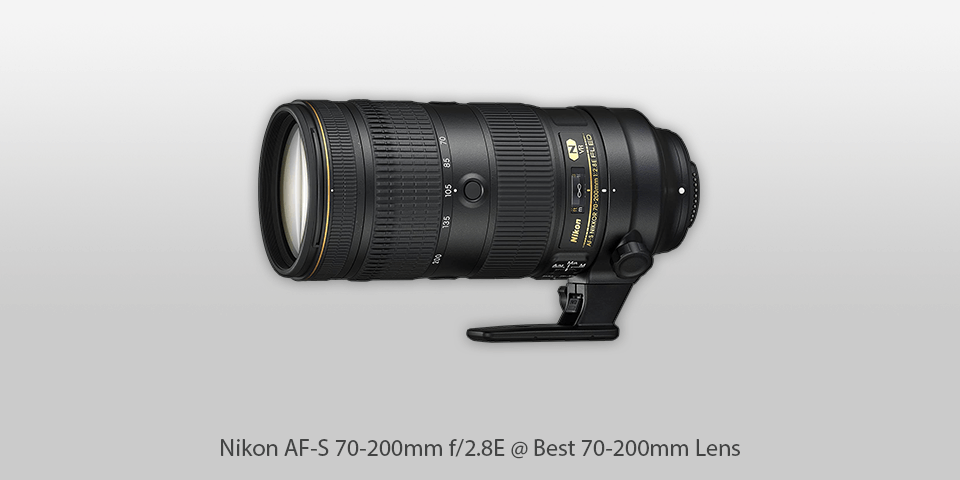
Mount: Nikon FX | Diaphragm blades: 9 | Autofocus: Ultrasonic (ring-type) | Min focus distance: 1.1m | Max magnification: 0.21x | Filter thread: 77mm | Dimensions (WxL): 89x203mm | Weight: 1430g
⊕ Sharp image
⊕ f/2.8 through zoom range
⊕ Optical stabilization
⊕ Long-lasting construction
⊕ Rotating tripod collar
⊖ Slight distortion
⊖ Dimmed corners at f/2.8
This model can be called the best 70-200mm lens, especially since this is an improved older version that was quite popular several years ago. It has a number of high-quality elements inside, including one fluorite, six Extra-low Dispersion, and one High Refractive Index elements. The design also features nano-structure coatings and is encased in a sealed shell cast from magnesium alloy that isn’t too lightweight but provides good protection.
The lens comes in its own protective case, has a reversible hood, and a rotating collar with a detachable foot. The latter is used to mount a camera on a tripod in a more stable position. It’s important because such heavy optics shift the center of gravity away from the mount in the camera body. There is no doubt the quality of the optics is superb but the price reflects that. It is a great option for a professional, who expects long years of intense use. Amateurs, however, would be better off with a more affordable alternative.
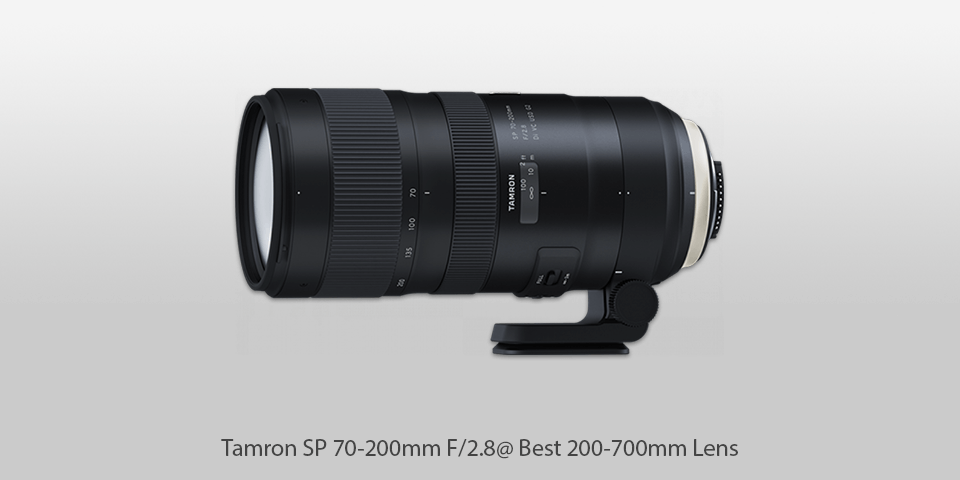
Mount: Nikon FX | Diaphragm blades: 9 | Autofocus: Ultrasonic (ring-type) | Min focus distance: 0.95m | Max magnification: 0.16x | Filter thread: 77mm | Dimensions (WxL): 88x194mm | Weight: 1485g
⊕ Diaphragm with 9 blades
⊕ 5 stops for enhancing VC performance
⊕ Protected by a 6-year warranty
⊕ Fluorine coating to repel water and oil
⊕ Broad compatibility
⊖ Minimum focus distance
⊖ Sluggish focus locking
This is a great 200 mm lens for those, who want something slightly more compact and affordable. For instance, it’s 300 full grams lighter than the next option. It has very sharp blades that help the shutter to close faster and take stunningly defined and crisp shots. This also makes working with a Teleconverter more efficient so definitely consider this model if that’s your aim. The autofocus is pretty agile, however, its performance becomes less satisfactory as the amount of light decreases.
If you want to shoot motion, this is also a decent option. It won’t reach the level of quality of the previous model but the results will still be very high. Especially if you compare this lens to others in this price category and weigh its few cons against the numerous pros. As a thoughtful bonus, the manufacturers include a removable tripod mount ring into the package, making this a truly great bargain.

Mount: Canon EF | Diaphragm blades: 11 | Autofocus: Ultrasonic (ring-type) | Min focus distance: 1.2m | Max magnification: 0.21x | Filter thread: 82mm | Dimensions (WxL): 94x203mm | Weight: 1805g
⊕ Fast autofocus when attached to Canon EOS R
⊕ Can withstand any weather
⊕ Crisp images
⊕ Blurs the background beautifully
⊕ Sensible price
⊖ Large barrel
⊖ Big weight
This is an entirely new 70-200mm lens design from Sigma that received countless enhancements. This complexity, though, results in nearly the single flaw of this optical device, making it a very bulky lens. It is one of the biggest among competitors and reaches 20.3cm at 1.8kg of weight. It has two dozen various elements that include nine FLD and one SLD among the rest. The mechanism includes an 11-blade diaphragm that creates a pretty round aperture.
You can run on automatic or manual autofocus mode and if set to the second, you are even allowed to override the AI Servo mode. You can also find three AF-stop buttons. They are very handy because on pro-grade cameras you can set them as AF-on. Though the lens is bulky, it produces outstanding image quality and also has a lower price than the similar Canon and Nikon representatives so this one flaw can easily be overlooked.

Mount: Sony E | Diaphragm blades: 11 | Autofocus: Ultrasonic (ring-type) + Dual Linear Motor | Min focus distance: 0.96m | Max magnification: 0.25x | Filter thread: 77mm | Dimensions (WxL): 88x200mm | Weight: 1480g
⊕ Circular 11-blade aperture
⊕ Max reproduction ratio of 0.25x
⊕ Enhancing Nano AR coating
⊕ Powerful image stabilization
⊖ Reaches 5 pounds of weight
⊖ Very tight zoom ring
If you are trying to equip a Sony body with the best 70-200mm lens, this model is certainly going to make your favor. On A7 or 9 body series, it looks somewhat out of place, but this combination can still be used just fine. You can find convenient focus hold buttons at the front. The lens also features OSS stabilization but the manufacturer didn’t give any official rating for that. In practice, combined with an A7 camera model’s stabilization, it equals to five stops of improvement at its best.
You can use this lens with equal success for videography and photography, getting sharp results either way. The 11 blades of the aperture cause beautiful soft bokeh. You can forget about reflections ruining your shot with the Nano AR coating combined with an XA element. These also ensure great rendition in any environment. It is definitely a great choice for photographers with the same camera brand but even when mounted on other bodies it produces great results and should be held high in lens ratings.
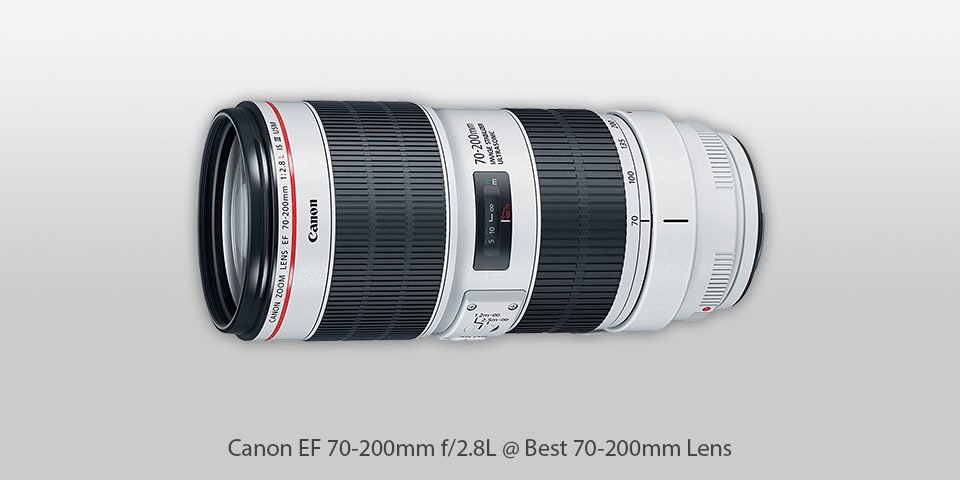
Mount: Canon EF | Diaphragm blades: 8 | Autofocus: Ultrasonic (ring-type) | Min focus distance: 1.2m | Max magnification: 0.21x | Filter thread: 77mm | Dimensions (WxL): 89x199mm | Weight: 1480g
⊕ Focusing range from 3.9 feet
⊕ Stabilization of 3.5 stops
⊕ Impenetrable by dust or moisture
⊕ Air Sphere Coating eliminates flare and ghosting
⊕ Additional fluorine coating
⊖ Issues in compatibility with other brands
⊖ Too high price
This 200 mm camera lens is an incredible piece of optics. If the Mark II was popular and praised, this next-generation model stands a good chance of exceeding that popularity. Its lighter color is not the only difference, the objective also received fluorine coating that prevents the grease and water from clinging. It affects the clarity of the image as much as the ease of cleaning.
With 3.3 pounds of weight, it’s not too heavy to handle, and the ability to use a tripod mount clears that issue out entirely. All those inner elements that increase the weight, result in outstanding image quality. It is further enhanced by the stabilization system that is quite powerful and works especially well at the highest zoom values. The lens also has a convenient f/2.8 aperture that captures enough light and can blur the background nicely or create soft bokeh.
The lens works well when the light is insufficient and has a great focusing capability with a short minimum distance. Altogether, this is a great piece of optics and even its price remains competitive, though rather high.
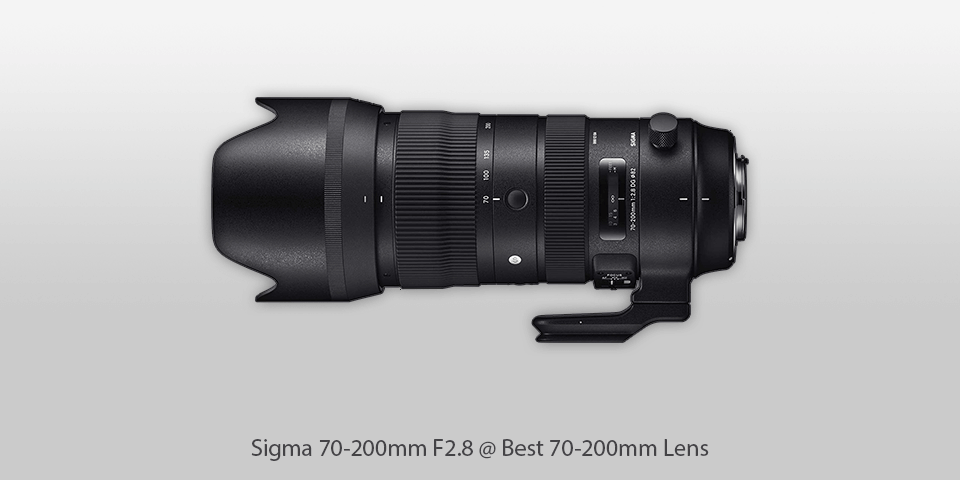
Mount: Nikon FX | Diaphragm blades: 11 | Autofocus: Ultrasonic (ring-type) | Min focus distance: 1.2m | Max magnification: 0.21x | Filter thread: 82mm | Dimensions (WxL): 94x203mm | Weight: 1805g
⊕ True Ultrasonic lens
⊕ Wide f/2.8 aperture
⊕ 4 stops of stabilization
⊕ Has manual focusing and AF motor
⊕ Enhanced multi-layer coating
⊖ Heavy, tires your hand
⊖ Bokeh occasionally loses smoothness
If you have a Nikon camera and would like to equip it with the branded lens but can’t afford it, there’s an option for you. This 200mm telephoto lens made by Sigma is a good match in quality, performance, and even handling, even though it is considerably cheaper. The price difference in this case does not signify the loss of quality. It is not a lightweight optical device, but the weight should be a bearable compromise for those who have a limited budget and no tolerance of image flaws.
The lens will provide a highly-detailed image even as you crank that diaphragm to its widest. Incidentally, the aperture does go wide, down to f/2.8. The objective also avoids chromatic aberrations and other distortions. That with a great image stabilizing mechanism results in pro-level visuals obtainable even in unfavorable conditions. It also has an agile autofocus. Altogether, this lens is great and there is no reason why the lower price should alarm you.

Mount: Canon EF | Diaphragm blades: 8 | Autofocus: Yes | Min focus distance: 1.2m | Max magnification: 0.21x | Filter thread: 61mm | Dimensions (WxL): 76x172mm | Weight: 760g
⊕ Ring-type ultrasonic motor
⊕ 34-12-degree diagonal viewing angle
⊕ Operates on 16 elements in 13 groups
⊕ Supported by most SLR cameras
⊕ Circular polarizing filter
⊖ No image stabilization
⊖ Quite a bulky model
Another great 200 mm camera lens by this brand has a few differences but equally high build quality. It might not be the best option for a full-frame sensor camera but there are some great features worth paying attention to. The lens received great optical image stabilization which allows you to lower the shutter speed and still get a crisp shot. You can call it a must-have for photographers with limited finances.
A great benefit of this model is that it’s completely weather-sealed and can stand any outdoor conditions. That with its zooming capabilities and the shutter speed make it the best option for wildlife and nature photographers with a tight budget. It is not an expensive lens, especially when compared to several earlier alternatives, but the quality of the image it produces is excellent for the price.
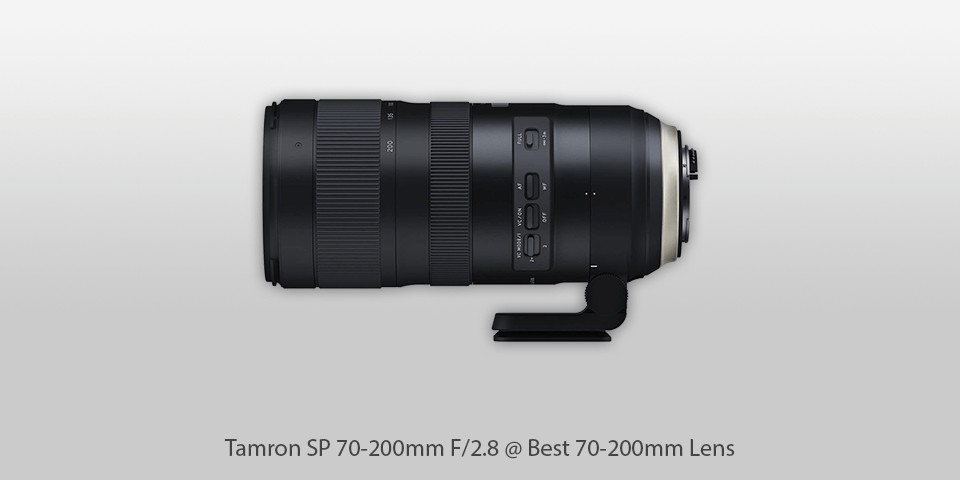
Mount: Nikon FX | Diaphragm blades: 9 | Autofocus: Ultrasonic (ring-type) | Min focus distance: 0.95m | Max magnification: 0.16x | Filter thread: 77mm | Dimensions (WxL): 88x194mm | Weight: 1485g
⊕ Vibration reduction
⊕ Stable and quiet autofocus
⊕ 5-stop stabilizer with three modes
⊕ Top-notch build
⊖ Less sharp than Sigma lens
⊖ Plastic barrel
The 70-200mm lens from Tamron is compact and light. It weighs 300g less than its competitor the Sigma 70-200mm f/2.8 DG. Its price is reasonable. Plus, a fully removable tripod mount ring with an Arca-Swiss compatible foot is included.
The lens has fast autofocus. You may have some problems with it only in the lowest light conditions. It is a great choice if you are going to photograph moving subjects. Perhaps this 200 mm camera lens loses a little in quality to other models, but it is quite good for the money.
Overall, this is the best combination of value and quality among the lenses in this category. It has more advantages than disadvantages and it still fits your budget. Moreover, this lens is an excellent option for those who want more variety in their images.
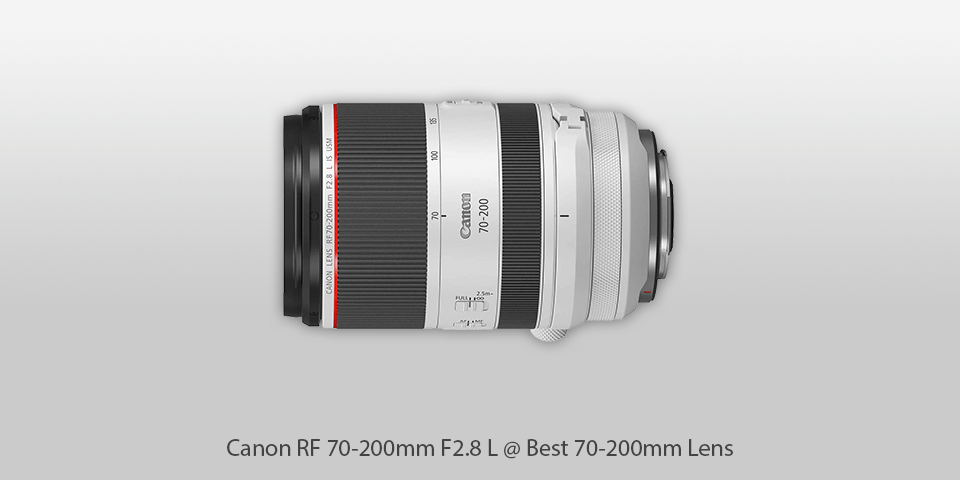
Mount: Canon RF | Diaphragm blades: 9 | Autofocus: Dual Nano Ultrasonic | Min focus distance: 0.7m | Max magnification: 0.23x | Filter thread: 77mm | Dimensions (WxL): 90x146mm | Weight: 1070g
⊕ Amazing compactness and small weight
⊕ High-end build quality and control
⊖ It extends when you zoom in
⊖ Not everyone can afford it
This new 200mm telephoto lens for R-series cameras smashes all your expectations of bulky optics with a fixed physical length when zooming in and out. It has an inner barrel expanding when the focal length changes. This feature is more common for 70-300mm lenses. The advantage of this lens is its compactness and low weight. It weighs a little more than a kilogram and is quite small for this optics class.
While the Canon RF 70-200mm and a few other mirrorless models fall into a different category, I’ve picked up the best current options on this list. Of course, you can find a 70 - 200mm zoom lens at a lower price. However, if you want more features, durability and better quality at your disposal, you will have to spend more.
| Image | Name | Features | |
|---|---|---|---|
 |
Nikon AF-S 70-200mm f/2.8E
Our choice |
CHECK PRICE → | |
 |
Tamron SP 70-200mm F/2.8
Sharp |
CHECK PRICE → | |
 |
Sigma 70-200mm F2.8
Weather sealed |
CHECK PRICE → |

When choosing the best 70-200mm lens, you should pay attention to its weight. Too heavy lenses are inconvenient to use, and your hand will get tired very quickly. Opt for lighter models to reduce the strain on your wrist and make photography more comfortable.
Light dispersion affects the sharpness and clarity of the picture. If it is too high, your photos will look blurry. When purchasing a 200 mm lens, check if it has a mechanism to reduce light dispersion.
This is another key factor that you must keep in mind if you are not going to shoot only within your studio. The weather can be very changeable, and you need to be sure that your equipment is safe in all conditions. Make sure the 70-200mm lens you like has a weather-resistant coating on it.
Speed is one of the main factors affecting the image quality when you capture moving objects. Since 70-200mm optics is considered professional, they can provide you with fantastically fast autofocus. This feature is very important for fast-paced shootings.
A 200 mm camera lens is built for professional photographers and is incredibly durable. Thanks to the weather sealing and metal casing, it can serve you for a very long time, even with daily use.

Using a 1.4x teleconverter with the 70-200mm optics gives you a 105-300mm equivalent. To have the equivalent of a 140-400mm, you need to combine the lens with a 2.0x converter. This will allow you to get extra reach without buying a super-telephoto.
In other words, you are interested in the “reach” of a lens. Typically, 70-200mm optics gives a 2.85 x zoom. If we consider 55mm as the norm, then with a 200mm lens, your object will be 4 times closer and it will seem 8 times closer with 400mm one. Thanks to this, you can better understand what each focal length looks like.
If you are a landscape or nature photographer, a good 70 - 200mm zoom lens is an important part of your equipment. With the available focal length, you can capture the details you want, reach distant scenes and get beautiful scenery shots.
It is difficult for portrait photographers to achieve outstanding results without the 70-200mm f/2.8 lens. This optics can provide everything a portrait shooter needs, including excellent build quality, a range of good focal lengths and a wide aperture.
A 70-200mm lens is an essential piece of photography equipment. It features excellent flexibility and impressive performance. While you may think that 200mm isn’t enough for wildlife photography, it can be a good starting point for you. Use it with an APS-C camera and develop your photography skills for amazing results.

 Rating
Rating